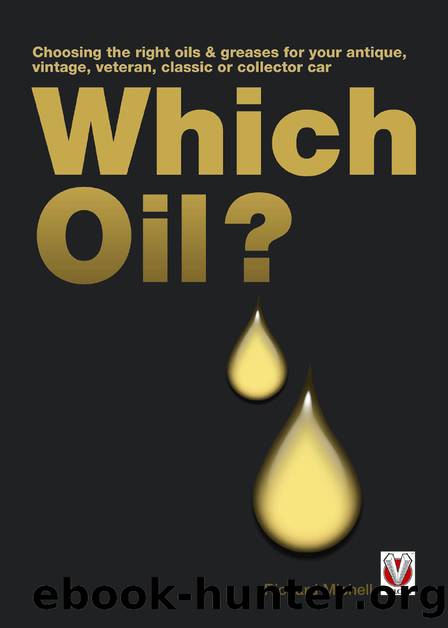Which Oil? by Richard Michell

Author:Richard Michell
Language: eng
Format: epub
ISBN: 9781845846275
Publisher: Veloce Publishing Ltd
Published: 2013-10-28T00:00:00+00:00
Figure 6.1
Table 6.1 SAE J306 viscosity grades for automotive gear oils.
SAE viscosity grades
* Old refers to pre-2005, new to 2005 and beyond.
70W (new)*
Viscosity cSt at 100°C (min) - 4.1
Max T for viscosity of 150 poise (°C) - -55
75W (old)*
Viscosity cSt at 100°C (min) - 4.1
Max T for viscosity of 150 poise (°C) - -40
75W (new)
Viscosity cSt at 100°C (min) - 4.1
Max T for viscosity of 150 poise (°C) - -40
80W (old)
Viscosity cSt at 100°C (min) - 7.0
Max T for viscosity of 150 poise (°C) - -26
80W (new)
Viscosity cSt at 100°C (min) - 7.0
Max T for viscosity of 150 poise (°C) - -26
85W (old)
Viscosity cSt at 100°C (min) - 11.0
Max T for viscosity of 150 poise (°C) - -12
85W (new)
Viscosity cSt at 100°C (min) - 11.0
Max T for viscosity of 150 poise (°C) - -12
80 (new)
Viscosity cSt at 100°C (min) - 7.0
Viscosity cSt at 100°C (max) - Less than 11.0
85 (new)
Viscosity cSt at 100°C (min) - 11.0
Viscosity cSt at 100°C (max) - Less than 13.5
90 (old)
Viscosity cSt at 100°C (min) - 13.5
Viscosity cSt at 100°C (max) - Less than 24.0
90 (new)
Viscosity cSt at 100°C (min) - 13.5
Viscosity cSt at 100°C (max) - Less than 18.5
110 (new)
Viscosity cSt at 100°C (min) - 18.5 Less than 24.0
140 (old)
Viscosity cSt at 100°C (min) - 24.0
Viscosity cSt at 100°C (max) - Less than 41.0
140 (new)
Viscosity cSt at 100°C (min) - 24.0
Viscosity cSt at 100°C (max) - Less than 32.5
190 (new)
Viscosity cSt at 100°C (min) - 32.5
Viscosity cSt at 100°C (max) - Less than 41.0
250 (old)
Viscosity cSt at 100°C (min) - 41.0
250 (new)
Viscosity cSt at 100°C (min) - 41.0
Most of the cars of interest to us were manufactured during the period when the old system applied, or even prior to its development. The car manufacturersâ requirements were, therefore, probably specified under that system. So, today we have the challenge of not only understanding what the manufacturer of our car was specifying at the time that it was built, but also of translating that understanding across to todayâs oils, under the potentially confusing situation where, although much of the terminology used then and now is the same, its meaning is potentially slightly different.
Although gear oils and engine oils use different SAE numbering systems (compare Tables 5.6 and 6.1), the viscosities that the two systems specify overlap. This is shown in Figure 6.1. You will see that, at 100°C, the viscosity of an SAE 50 engine oil equates to the viscosity of an SAE 90 gear oil (old scale). You will also note that, because of the wide gear oil viscosity grades under the old system, an SAE 40 and an SAE 60 engine oil may also equate to an SAE 90 gear oil. Make sure that you understand which oil type is being referred to when a manufacturer specifies the use of a particular SAE viscosity grade.
Source of SAE gear oil viscosity grade numbers
If youâre wondering where the gear oil viscosity grade numbers â the 90, 140, etc â came from I can give you a clue. The
Download
This site does not store any files on its server. We only index and link to content provided by other sites. Please contact the content providers to delete copyright contents if any and email us, we'll remove relevant links or contents immediately.
| Buyers' Guides | Classic Cars |
| Customize | Driver's Education |
| Electric & Hybrid | Foreign |
| History | Industry |
| Insurance | Luxury |
| Motorcycles | Pictorial |
| Racing | Repair & Maintenance |
| Trucks & Vans |
Machine Learning at Scale with H2O by Gregory Keys | David Whiting(4257)
Never by Ken Follett(3875)
Urban Outlaw by Magnus Walker(3364)
OPNsense Beginner to Professional by Julio Cesar Bueno de Camargo(3261)
Sapiens and Homo Deus by Yuval Noah Harari(3025)
Will by Will Smith(2872)
A Short History of Nearly Everything by Bryson Bill(2657)
Hooked: A Dark, Contemporary Romance (Never After Series) by Emily McIntire(2527)
Rationality by Steven Pinker(2326)
Borders by unknow(2280)
The Becoming by Nora Roberts(2148)
Holy Bible (NIV) by Zondervan(2100)
HBR's 10 Must Reads 2022 by Harvard Business Review(1820)
A Short History of War by Jeremy Black(1815)
The One Percenter Encyclopedia by Bill Hayes(1810)
Freedom by Sonny Barger(1783)
Go Tell the Bees That I Am Gone by Diana Gabaldon(1729)
Five Ways to Fall by K.A. Tucker(1723)
Girls Auto Clinic Glove Box Guide by Patrice Banks(1706)
